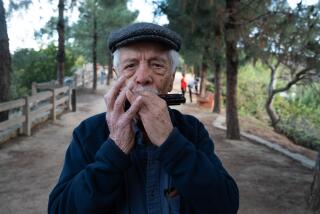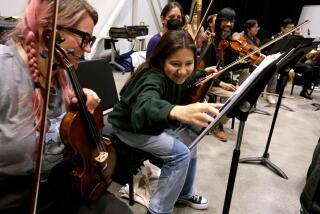Sweet Harmony : 200 Harmonica Buffs Gather to Socialize, Perform and Talk High-Tech at Anaheim Conclave
- Share via
They probably will never get to perform at Carnegie Hall. And it’s unlikely that one of their songs will ever hit the top of the record charts. But for this group of die-hard harmonica players, the point is fun, not fame.
More than 200 harmonica enthusiasts from throughout the West converged on an Anaheim hotel this weekend for a three-day convention, to socialize, jam and learn about latest harmonica high-tech.
The covention was open to anyone even remotely interested in harmonicas, but there seemed to be two major requirements: Everybody had to carry at least one harmonica at all times, ranging from the pocket-sized Chromatic to an elaborate 8-inch long chord instrument, and they had to be prepared to join an impromptu concert at anytime. The hotel lobby, the coffee shop, the pool area--anywhere two or three gathered together--was fair game.
Most of the harmonica buffs became hooked as children. For many, retirement meant the chance to devote full time to their music, performing free for anyone who would listen.
“Most of us fell in love with the harmonica when we were kids. When you get older and life begins to slip by you, you revert back to what you enjoyed as a child. We didn’t have television sets back then, but we had harmonicas,” said Nick Vorona, leader of the After Five Harmonica Players, an Orange County group that sponsored the convention at the Inn at the Park.
Most of the participants are members of the Society for the Preservation and Advancement of the Harmonica, an international group of more than 3,500. Organized 25 years ago, the group meets annually in Detroit. Five years ago, the California branch began holding annual meetings in Anaheim for those who couldn’t afford to go to Detroit.
According to the group, some of the most notable members include recording artists Stevie Wonder and Larry Adler, as well as Jerry Murrad and the Harmonicats.
Charlie Carter, better known as “Uncle Charlie,” has been playing the harmonica for 62 years. It all began when his father gave him a small Chromatic when he was 9. Now, he says, he owns at least 46 harmonicas and boasts 16 gold medals he won at the Senior Olympics Harmonica Contest that is held annually in Culver City.
“I used to play at high school dances for $5 a night, and that was pretty good money back then,” said Carter, 72, of Los Angeles. “Now, I’m sort of a one-man band. I have an electronic keyboard that I use when I play my harmonica. I perform at nursing homes, hospitals, all over.”
Carter, a retired cheese maker, said he never leaves the house without his harmonica. A miniature harmonica hangs on a gold chain around his neck.
“When I get tired of waiting for an elevator, I pull it out,” he said. Then he placed the miniature harmonica to his mouth and belted out a verse of “Walking My Baby Back Home.”
Clara Hammers, 74, is pretty well known in some circles in Seattle for her 22-member band. The group, which she organized 12 years ago with a group of friends at a senior citizens center, performed 48 engagements last year.
“It’s very unusual that women play harmonicas, but I’ve been playing since I was 5,” she said. “I didn’t play for 40 or 50 years because I was working and raising a family. Then my husband died, and I got back into it.”
Friday morning, Dick Lawrence, an accomplished chord musician from Phoenix, was teaching Frank Hatanaka, of Anaheim, how to play the theme from “Hawaii Five-O.” Saturday night would be the first time Hatanaka, 67, would perform in public on a chord harmonica, and he had a long way to go.
“I’ve always wanted to play with a group, and when the chance came, I took it,” said Hatanaka, a member of the After Five band. “I like to play songs from the big band days in the 1930s and 1940s.”
Lawrence, an air traffic controller, said his hobby is fun but expensive.
“Most people don’t know that the harmonica is the most popular instrument in the world when you think about how many people have one. But the prices these days go up to about $600,” he said.
“You get started on a less expensive one, and you end up having to get a $600 amplifier to go with it, a trailer to carry that in, and two or three thousand dollars worth of harmonicas.”
Gordon Mitchell is a full-time hydraulics engineer in Troy, Mich., but in his free time he serves as president of the international harmonica association. As a teen, Mitchell, 61, toured the country with Borrah Minevitch and the Harmonica Rascals, a popular vaudeville group in the 1930s. Their 78-rpm record, “Always in My Heart”, became a hit in the late 1930s, and they became familiar faces in movie fillers that ran between showings at theaters.
“We wore uniforms that emulated ragamuffins, knickers, knee-high socks and shirts that were tattered and torn. We used sheet music when everybody else was playing by ear and we spent eight hours a day rehearsing, but nobody knew that. What was conveyed to the audience was that this group of street kids got together and made beautiful music on the harmonica. It made people look up and say, ‘My God, how do they do that?”
HARMONICA TRIVIA
Soaking a harmonica gives it more volume with less effort by the player. Some performers who play for hours at a stretch hold their harmonicas under a faucet or soak them, often in their favorite spirits (or beer, which makes for a sticky harmonica.) Another advantage: Notes are easier to bend. The disadvantage: The harmonica eventually rusts.
M. Hohner, the traditional manufacturer of harmonicas, has produced instruments ranging from Little Lady, with eight reeds (holes) to the Chord Harmonica, two harmonicas hinged together with a total of 384 reeds.
Sometimes a reed will clog and go flat. One remedy is putting the harmonica in boiling water, then running it under cold water. The heat expands the instrument, and then the cold contracts the metal and the wood at a different rate, hopefully clearing the reed.
By the 1930s, production of harmonicas was about 25 million in the United States. Until World War II, the average price was 50 cents. Today, the average price is about $15, the top price more than $600.
Jerry Murrad and the Harmonicats’ 1960s recording of “Peg o’ My Heart”--an instrumental with only harmonicas--sold 7 million copies.
The harmonica dates to an invention by Benjamin Franklin in 1763, called the glass harmonica. That was a series of bowl-shaped glasses arranged in order of size on a spindle. Music was made by holding the finger against the wet rim as it rotated. Wolfgang Amadeus Mozart once composed a quintet for the glass harmonica, flute, oboe, viola and violoncello.
Sources: Louis Sahagun, Times staff writer and harmonica player; “Blues Harp” by Tony (Little Son) Glover, 1965; and Nick Vorona of the After Five Harmonica Players.
More to Read
The biggest entertainment stories
Get our big stories about Hollywood, film, television, music, arts, culture and more right in your inbox as soon as they publish.
You may occasionally receive promotional content from the Los Angeles Times.










